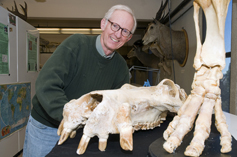Burke Mammalogy
What is mammalogy?
Mammalogy is the study of mammals and their diversity and distribution on earth. Vertebrate animals (those with backbones) that have hair and produce milk for their newborns make up the class Mammalia. The 5,416 living species of mammals are spread throughout all the earth's environments and make up 29 diverse orders, such as carnivores, whales, bats, rodents, and primates, to name just a few.
What is the mammalogy collection at the Burke Museum?
The Burke Museum's mammalogy collection consists of 54,785 specimens (as of 2010) and includes 70 species of carnivores, 140 bat species, 262 rodent species, 38 primate species, and 37 marine mammal species. Only a few of our specimens are on view in the museum galleries.
The collection is represented by specimens from North America, South America, Asia, Africa, Australia, and Europe. Over half of the specimens (26,292) are from Washington State. Other well represented areas include Oregon (11%), British Columbia (4%), and Alaska (4%).
How does the mammalogy collection get used?
The Burke Museum's Mammalogy Program provides graduate students and undergraduates with opportunities for research onthe ecology, evolution, biodiversity, biogeography, and conservation of mammals. With this experience, students are prepared for careers in research, education, and related professional areas. The specimens and associated database of the Burke Museum's mammalogy collection are available to qualified researchers.


